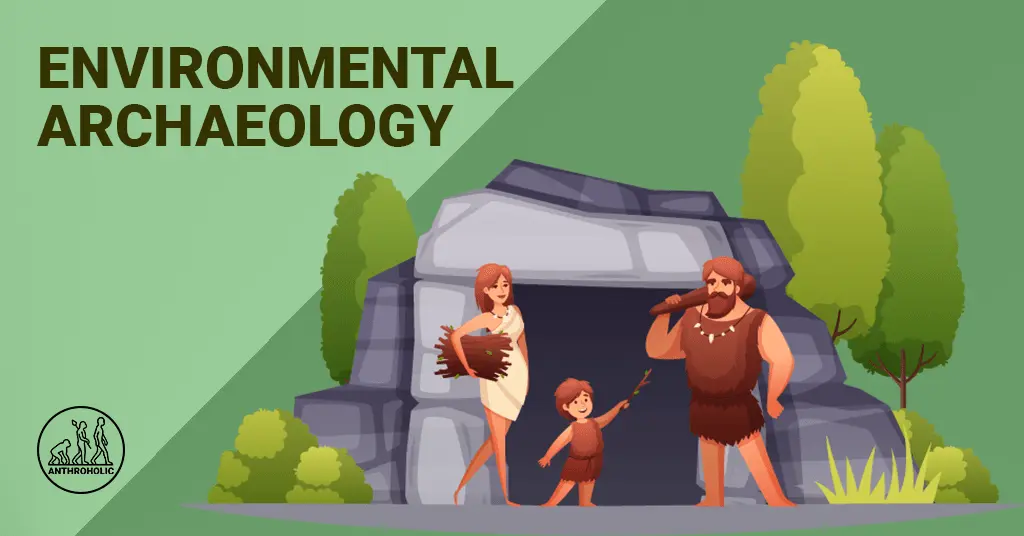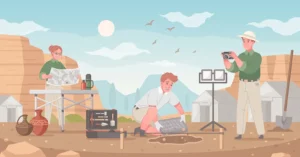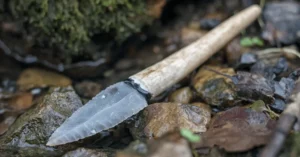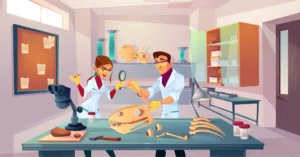AI Answer Evaluation Platform Live Now. Try Free Answer Evaluation Now
Environmental Archaeology
Environmental archaeology is a discipline of archaeology that was originally researched in the 1970s [1]. It is the study of how past civilizations interacted with their environments [2]. The region provides an archaeological-palaeoecological approach to investigating the paleoenvironment by employing human palaeoecological techniques. Archaeologists obtain insights into the birth and evolution of anthropogenic settings, as well as prehistoric adaptations and economic activities, by recreating past environments and the links and interactions of historical people with the landscapes they inhabited. [3]

Environmental archaeology frequently examines plant and animal remains to identify which species were there and how they were handled throughout prehistoric habitations. The evaluation of the physical world’s evolution across time and how similar or unlike it was in the past may also be necessary. Such enquiries include an essential component, the evaluation of site creation processes [4]. This category is particularly useful when things are missing from a site that has been excavated or surveyed, or when erosion or other earth movement may have buried artefacts and archaeological features. But the word “environmental” is used generally to refer to a branch of science that has relevance for all the historical periods and geographical areas that archaeology as a whole has explored. What defines specialized subfields like bioarcheology or geomorphology are the materials that are examined in them. [5]
Three sub-fields of environmental archaeology
1. Archaeobotany
Archaeobotany, or the study of plant remains, is the investigation and study of plant remains. Researchers can recreate ancient human meals, as well as their subsistence strategies and plant economics, by studying plant use in historical contexts. Greater awareness of a people’s social and cultural practices is achieved as a consequence [6]. Analyzing a sample, such as wood charcoal, may reveal where a society obtained its building materials or fuel. Along with pollen and starch, archaeobotanist frequently analyze the remains of seeds, fruits, and flowers [7]. There are various strategies to preserve plants, but the most prominent ones are desiccation, mineralization, water logging, and carbonization. A branch of Archaeobotany called ethnobotany focuses on the interaction between people and plants as well as the cultural impact that plants have had and still have on human communities.. The usage of plants for food, agriculture, or medicine, as well as their economic repercussions, are of interest [8].
2. Zooarchaeology
Zooarchaeology (the study of faunal relics) (the study of faunal remnants). The study of animal remains and what they may disclose about the human civilizations the animals once lived in is known as zooarchaeology[9]. Animal remains may be used to illustrate domestication or human predation. Animal bones, skins, or DNA recovered at a specific site could describe the area’s historical ecology or climate in addition to disclosing the exact relationships between animals and humans.
2.1 Compounds of Zooarchaeology
Bones are the most common vertebrate remains found in archaeological and geological records (for example, fish, and small and large animals). They may be distinguished to establish the animal’s genus or species, whether it is wild or domesticated, the sort of bone it possesses (such as a femur), and its sex and age. These data enable us to appreciate human economy and food; specifically, hunting and husbandry skills, pathologies, and ancient ecosystems can be reconstructed.
Measurements of the stable carbon (13C) and nitrogen (15N) isotope ratios of collagen, lipids, and cholesterol in human bones and tissues, in addition to quantitative methods like bone measurement and weight, have improved understanding of the significance of terrestrial and marine food, the use of exotic food, and changing dietary patterns. Quantitative reconstructions of historical climatic regimes have also been constructed using analyses of oxygen isotopes (180) in animal bone phosphate that correspond to regional meteoric water values (the animals’ drinking water) and mean annual air temperature.
3. Geoarchaeology
The study of geological processes and their relevance to the archaeological record is known as geoarchaeology.. In order to understand how prior civilizations may have been affected or influenced by the environment, it investigates ecosystems throughout the human chronology. The majority of artefacts are found in sediment and soil, which draws a lot of investigation as both natural processes and human activity may modify the soil and expose its history[10]. In addition to eye observation, satellite imagery and computer programming are commonly used to reconstruct historical landscapes or structures.
Geoarchaeology effect on human culture
Human civilizations rely on the materials that local flora and wildlife, the availability of water, and the elements of the earth offer. The extent and nature of this reliance have shifted as our species has progressed. The question of whether the availability of raw resources for preserving life and other necessities has an impact on cultural evolution and how, in turn, the underlying natural forces of climate and geology affect such change is genuine. It is tough to detect and comprehend these relationships because they interact in so many diverse geographical and temporal domains. We must construct integrated methods in order to appreciate the linkages between the myriad variables and driving forces that link human cultural development with natural resources.
Paleoenvironments and climate Short-term occurrences that have an immediate effect, including floods and droughts, may have an influence on seasonal climate changes. However, the timelines of climate change also include longer-term changes that, in most conditions, may last far longer than a human lifetime. Furthermore, climatic trends may be progressive rather than episodic, leading to major changes that influence local people by changing temperatures and precipitation patterns.
In order to identify what is more likely to be the cause of deforestation or desertification, it is vital to distinguish between the consequences of climate change and human activities on the variety and distribution of flora. When information on cultural change is linked with evidence of climatic change in a clearly defined geographical and historical context, it may be possible to establish how people adapt to environmental change.
Geoarchaeology- Geology
Similar to geologists, geoarchaeologists frequently focus on chronology, sedimentation, and stratigraphy. Unlike most geologists, geoarchaeologists attempt to explain these characteristics in the context of earlier human presence in an area. For instance, geoarchaeologists concentrate on the distribution of raw materials (used to create tools, art, or food) as well as the preservation of archaeological sites, all of which have an influence on the geomorphology of archaeological sites.
Combining the physical qualities of the raw materials with historical and geomorphological data can help us grasp cultural progress and continuity over time. Our understanding of how far human groups may have travelled in search of resources, who they may have traded with, and why people choose to live in particular settings can be influenced by the governing processes involved in the weathering of bedrock that facilitate the exposure, transport, and deposition of mineral and rock resources.
Geoarchaeology- Housing for individuals
The precise circumstances that foster human settlements are typically closely tied to the accessibility of resources. A site of habitation is developed in time and space in order to take advantage of the benefits supplied by the neighboring terrain. Since building sites are typically meant to exploit resources, it is vital to have access to or be adjacent to raw materials. Societies face major challenges when their local resources run out that may only be solved by obtaining new resources or partaking in trade, which could signal culturally important events.
Geoarchaeology also includes the influence of geomorphological changes on the preservation and destruction of ancient archaeological sites. Because people have exploited rivers as transit routes and venues for resource extraction, fluvial systems are especially significant. Fluvial geomorphology is compounded by cyclical processes of erosion and deposition that result in site burial or disappearance from the archaeological record via erosion. By utilizing geoarchaeological methodologies to determine the depositional and erosional chronologies of subsurface sediments, researchers may make predictions about the locations of prospective archaeological sites in buried settings. For studying archaeological sites from the late Pleistocene and early Holocene eras all around the world, site prediction modelling is very important.
The main focus of site taphonomics investigations is on the geological processes that have an impact on archaeological sites across time. For instance, burial and erosion are two geomorphological processes that alter site taphonomy. To determine the timing and significance of these events, studies in geochemistry, geophysics, chronology, stratigraphy, microstratigraphy, and geochemistry are all used.
Geoarchaeology– Blending Numerous Influences
Identification of causal linkages has generally been the outcome of coincidence rather than a systematic analysis and modelling of the ties between social and cultural evolution, climatic change, and geology. A method that may combine diverse data sets within the same geographical and temporal framework may be used to study with purpose, for example, how societal progress is functionally related to resources or influenced by climate change. We wish to provide a focused search for answers to challenges in order to assist scholars in archaeology, geology, and climatology better understand the essential mechanisms that drive cultural development and the nature of society’s reactions to crises in resource availability.
Historical Perspective of Environmental Archaeology
Over the past 50 years, environmental archaeology has become a distinctive area of research[11]. Its relevance has expanded dramatically in recent years, and it is now a trustworthy aspect of the majority of excavation operations. To gain a more comprehensive understanding of past human livelihood and people-environment interactions, particularly how climatic stress affected humans and forced them to adapt, environmental archaeologists, palaeoecologists, and archaeologists and anthropologists with a focus on material culture studies collaborate with one another in this multidisciplinary field.[12]
In the 1960s, the environment was assumed to interact with humans in a “passive” fashion in archaeology. Nevertheless, this worldview began to alter when Darwinism and ecological principles were added. This philosophy was accentuated by well-known theories and notions of the day, including the “oasis theory,” “catastrophism,” and “extended duration.” Catastrophism, for example, investigated how catastrophes like natural disasters might influence whether a society survives[13]. The environment may have an impact on human groups in the social, political, and economic arenas.
Examining the direct influence that the environment may have on a civilization becomes more vital for academics. Due to this, middle range theory was developed, and these issues were the main ones that environmental archaeology sought to address in the 20th and 21st centuries. Since then, research has produced two significant findings for environmental archaeology: South-west Asia is where both humans and agriculture first appeared.. The notion of cost-effectiveness was the subject of another key development in thought within the field. Archaeologists always believed that people constantly sought to maximize their use of resources, but they now believe that this is not the case. Following are some concepts and notions[:] Sociality, agency, and an emphasis on the connections between archaeological sites archaeologists always believed that people constantly sought to maximize their use of resources, but they now believe that this is not the case. Following are some concepts and notions[:] Sociality, agency, and an emphasis on the connections between archaeological sites[14]. In more recent times, the sub-discipline has also been affected by government research audits and the “commercialization” of environmental archaeology.
Environmental Archaeological Approaches
Environmental archaeologists explore a site through excavation and/or evaluation. In assessment, the accessible materials and objects are evaluated for any potential relevance. Similar to evaluation, excavation likewise involves samples from different layers of the ground. Animal and human bones, pollen and spores, wood and charcoal, insects, and even isotopes are typical materials.. Lipids, proteins, and DNA are examples of biomolecules that may divulge information[15]. Topographic computer systems and satellite photos are commonly used in geoarchaeology to reconstruct landscapes. A computer system that can analyze geographical data and construct virtual landscapes is termed a “geographic information system” (GIS).Through the use of paleoclimatology proxies, which may offer data on temperatures, precipitation, vegetation, and other climate-dependent elements, climatic records may be rebuilt.[16] These proxies may be used to contextualize the present climate and contrast it with prior climates.
Environmental Archaeology – “Natural History.”
Environmental archaeology employs what is commonly characterised as “natural history” investigation. Archaeologists must interact with professionals in various realms of natural scientific analysis to execute cooperative studies as the research areas utilised in environmental archaeology get more diversified. It is also necessary to consider the generality of the important research findings.Environmental archaeology can only be used successfully if those involved in archaeological excavation have a clear understanding of their goals.They also need to be informed and ready. Avoid introducing environmental archaeology in an uncertain way without a specific purpose in mind. Analysis is sometimes outsourced to other institutions, as natural scientific analysis might demand specialist equipment, materials, or chemicals.
In such situations, there must be a clear understanding of the goals shared by the person or persons in charge of the analysis and those in charge of arranging the archaeological materials at the site of the dig. It is vital to create a cooperative structure that assures the preservation of verified records while maintaining impartiality. Individuals who outsource analysis must not simply leave all results, including result interpretation, to those in charge of analysis, but must instead evaluate and summarize the results of analysis while referencing the findings of the excavation site study and the organization of archaeological materials. In light of this, even if one does not actually undertake analysis oneself, one still needs to have a fundamental knowledge of the theories and procedures applied in natural scientific analysis. Due to the fact that the process of extracting data from characteristics and/or artefacts is a natural scientific.
Conclusion
The technique of analysing the data generated by it, i.e., recreating human activities that happened at or around the time in question by studies carried out at the dig site, is no different from that of archaeology for a natural scientific inquiry. The outputs of natural scientific analysis help us grasp the dig more deeply and contribute to the findings of other archaeological investigations. Natural scientific analysis incorporates methodological assumptions and limits, much as in archaeology.
Therefore, the findings gained from natural scientific investigation are accepted as speculative suppositions (hypotheses) about the past. Instead of assuming that the results of analysis are absolute, it is necessary to combine analytical results with other archaeological findings and come up with a highly likely interpretation of the findings while taking into account the characteristics of the analysis sample and the problems with the analysis method.
FAQs about Environmental Archaeology
Suggested Articles
References
[1] O’Connor, Terry (2019). “Pinned Down in the Trenches? Revisiting environmental archaeology”. Internet Archaeology (53)
[2] “What is Environmental Archaeology?”. Florida Museum of Natural History. University of Florida. Retrieved 6 June 2016.
[3] Branch, Nick (2014). Environmental Archaeology: Theoretical and Practical Approaches. London: Routledge. ISBN 978-0340808719.
[4] Kris, Hirst. “Site Formation Processes”. about education. Retrieved 6 June 2016
[5] Butzer, Karl W. (2012). “Collapse, environment, and society”. PNAS. 109 (10): 3632–3639.
[6] Van Der Veen, Marijke (June 2007). “Formation processes of desiccated and carbonized plant remains – the identification of routine practice”. Journal of Archaeological Science
[7] Archaeobotany”. sites.google.com. Retrieved 2019-03-04.
[8] “Archaeobotany – Ethnobotany”. sites.google.com. Retrieved 2019-04-14.
[9] Zooarchaeology Lab — Anthropology”. anthropology.ucdavis.edu. Retrieved 2019-03-04
[10] Rapp, George Robert (1998). Geoarchaeology : the earth-science approach to archaeological interpretation. Hill, Christopher L., 1959-. New Haven. ISBN 9780300157345. OCLC 951622849
[11] Florida Museum. 2017-04-05. Retrieved 2019-02-23.
[12] Gkioni, Maria (2004). “The role of the environmental archaeologist in the study and reconstruction of cave palaeoclimate”. International Journal of Speleology. 33: 115–127. doi:10.5038/1827-806X.33.1.11 – via Scholar Commons USF.
[13] G., Evans, John (2003). Environmental archaeology and the social order. London: Routledge. ISBN 0203711769.
[14] G., Evans, John (2003). Environmental archaeology and the social order. London: Routledge. ISBN 0203711769.
[15] ones, David M., ed. (2011). Environmental Archaeology: A guide to the theory and practice of methods from sampling and recovery to post-excavation. English Heritage. Retrieved 2019-03-09.
[16] Climate Reconstruction | National Centers for Environmental Information (NCEI) formerly known as National Climatic Data Center (NCDC)”. www.ncdc.noaa.gov. Retrieved 2020-07-27.




